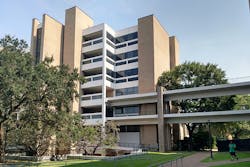Clemson University in Clemson, S.C., has begun a major renovation of three high-rise housing complexes that house more than a third of its first-year students.
The university says the overhauls of Manning Hall, Lever Hall and Byrnes Hall will cost $155 million and make the complex fully accessible to individuals with mobility disabilities. The buildings will get new roofs and other improvements to the exteriors. The main entrances will be moved to face one another and create a community courtyard and social space.
The three 11-story buildings, all built between 1967 and 1970, lodge about 1,400 students each year. That adds up to more than 75,000 Clemson students who have called the residence halls over more than five decades.
Much of the original mechanical, electrical and plumbing systems remain in the buildings, leaving the structures vulnerable to failures. All of these systems will be upgraded or replaced.
The decision to pursue renovation instead of demolition and rebuilding reflects Clemson's financial goal of providing quality housing at a rate competitive with peer institutions. Demolishing and replacing the buildings was estimated to cost $125 million more than renovation.
Kathy Bush Hobgood, Clemson’s associate vice president for auxiliary enterprises says the project will significantly improve the living spaces to maximize value while addressing student desires and needs.
“Currently, there are only common spaces and lounges on the first and ground floors in each building, and now there will be study and social space on every floor in addition to big beautiful new common areas,” she said. “Each common area will be different. For instance, one might have a big open lounge with a pool table, one may be more of a study area, and one will have a community front desk."
Room layouts will get significant upgrades. Community bathrooms will be replaced by “wet core” bathroom designs, creating small, more home-like private bath spaces with a shower and toilet in each area and a locking door.
The architect is Boudreaux + Little, and the general contractor is Juneau Construction.
Pennsylvania high school is getting a $73 million renovation
The Delaware County Daily Times reports that the $73 million project that will renovate and expand the 197,000-square-foot building, which is nearly 50 years old.
Interboro High has about 1,100 students. The building is being reimagined to provide a 21st-century learning environment to go along with new mechanical, electrical and plumbing systems, officials say.
The renovation will reconfigure all interior spaces and add 40,400 square feet of new space. Additions include a new cafeteria and art and science labs on the south side of the building.
Superintendent Bernadette Reiley said the project will take three years to complete, with work beginning on the new structures.
KCBA Architects is the designer on the project.
University of Houston renovations will bolster security at building where 2 students committed suicide
Houston Public Media reports that the renovation plans were announced after a task force studied the future of Agnes Arnold Hall, a five-story building with open-air hallways that historically houses more than 450 classes per week. The task force called for temporary screens to cover an outdoor stairwell as well as the balconies on each of the top four stories and sky bridges to an adjacent building.
A University spokesperson Chris Stipes said the lower basement level of the building, where the deceased students were found, will remain closed for the fall 2023 semester to allow "more time for our students to heal and recover."
"As part of our plan, we are committed to reopening Agnes Arnold Hall this coming fall, with security measures in place," Stipes said.
As part of a three-phase project to be completed over four years, permanent security screening will be installed along with enhanced security protocols that limits and better controls entryways into the building.
The task force said it considered the feasibility of demolishing the building because of the trauma associated with the deaths. But doing so would cost between $10 million and $15 million, and the cost of constructing a replacement building would be at least $167 million.
About the Author
Mike Kennedy
Senior Editor
Mike Kennedy, senior editor, has written for AS&U on a wide range of educational issues since 1999.



